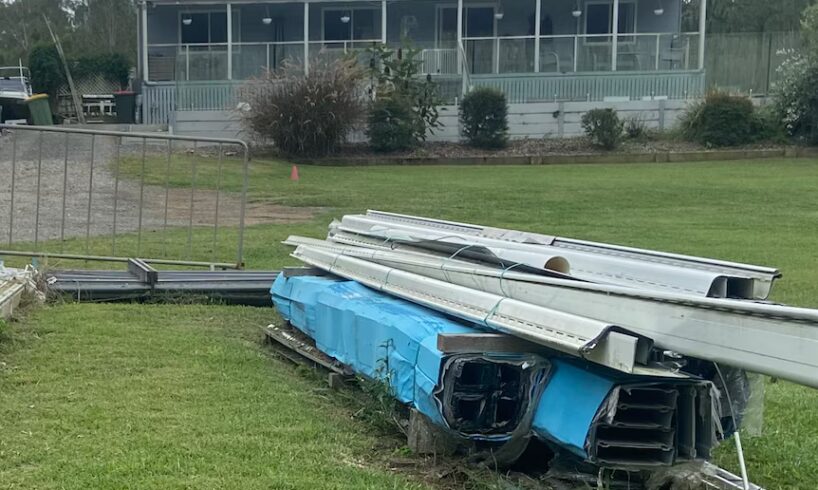
Ben Parkinson is proud of the five acres he calls home in south-east Queensland, but what is missing is the ability to develop his land.
For two years he has been “fighting an uphill battle” to have plans to build a gazebo or carport approved, but the Logan City Council has knocked back his application due to the risk of flooding.
In 2023 the council introduced a risk-based flood policy known as a Temporary Local Planning Instrument (TLPI) to guide its development decisions.
Mr Parkinson believes this is effectively a “blanket ban” on developing his property.
A council spokesperson told the ABC there was no blanket ban, and said development constraints only apply in certain types of areas on the overlay maps.
“I’ve petitioned council a number of times, it’s fallen on deaf ears,” Mr Parkinson said.
Mr Parkinson has filed a petition to the Queensland government in an attempt to bring a statewide approach to flood mapping. (Supplied: Ben Parkinson)
“It’s become a topical issue in the community and is causing a lot of stress and angst.”
The approach is unique to the Logan area, with local councils encouraged by the state government to create their own of fit-for-purpose flood mapping in the wake of the devastating 2011 floods.
How Queensland’s flood crisis played out
Flooding in 2022 also wreaked havoc on south-east Queensland.
Differences between modelling and mapping on same waterway
According to the government’s 2017 Guide for Flood Studies and Mapping in Queensland, which is currently under review, the techniques used in modelling flooding can “vary within a catchment”.
The document says more “sophisticated” techniques can be used in areas with “concentrated exposure” to risk, such as cities, while simpler techniques can be used in places where development is more widespread, such as rural areas.
With different techniques used on sometimes overlapping waterways, Mr Parkinson said he is concerned the council-by-council maps could undermine confidence in the state’s flood resilience.
“There are about three companies that have done four studies on the Logan River, and they all don’t align together,” he said.
Mr Parkinson’s rural-residential property in Munruben last flooded during the 2022 event, but he said water did not impact any structures. (Supplied: Ben Parkinson)
One example spotted by Mr Parkinson was in a one in 100 chance flood, depending on if residents were in the Logan City catchment or Gold Coast City Council area of the Logan River, they may experience up to a metre of difference in flood water height.
“There’s properties that are [a couple] hundred metres apart … with modelling done by the exact same company,” he said.
“We’re seeing quite a disparity based on what city you live in.”
Logan flood maps updated
It’s prompted him to take his concerns to the state government, launching a petition to suspend changes to local government flood overlays, a movement that has garnered about 4,500 signatures at the time of writing.
Councils taking different approaches
The state government provides framework to individual councils who are responsible for flood mapping.
In Brisbane, mapping is based on a slew of factors, including ground level surveys and historic flood and rainfall records.
The city council said it works closely with its neighbours to develop flood studies and share data.
Chair for Environment, Parks and Sustainability, Councillor Tracy Davis said although flood events cannot be prevented, being prepared can make a world of difference.
“No two floods are the same, but we are committed to giving residents the most up-to-date information, so they can make confident decisions to be prepared and protect their properties,” Ms Davis said.
More than 10,000 Brisbane properties to be added to Brisbane flood maps
In Logan, a nine-week long community consultation is drawing to a close to inform the city’s draft plan, including feedback on the way it implements the TLPI introduced in 2023.
A Logan City Council spokesperson said the tool helped to “make better decisions about where future homes and services can be safely located”.
“The proposed Flood Overlay in the draft Logan Plan guides what is permitted for future development in each flood risk area, and what mitigation measures apply to ensure the safety of people and property,” the spokesperson said.
Mr Parkinson said the Logan City Council has allowed him to raise his home in 2025, an exemption to planning legislation. (Supplied: Ben Parkinson)
In the bordering City of Gold Coast council, historic flood events are utilised to inform modelling, including rainfall and gauge levels, with climate change factors also considered.
The latest flood model is also informed by a city-wide scan in 2022 which created a 3D model of the area.
88,000 Gold Coast properties at flood risk
A council spokesperson said it endorsed a long-term flood hazard resilience approach but was in the process of adopting the state’s “risk-based approach to planning for flood.”
The spokesperson said there are not blanket bans on building across the city, but waterfront areas where inundation is permanent or deep in regular flooding faces restrictions.
“[Experts] can work with landowners to appropriately develop flood-affected land, where the risks to people and property can be adequately mitigated to an acceptable or tolerable level,” the spokesperson said.
Important to maintain at local level
University of Queensland hydraulic engineering professor Hubert Chanson said local governments had a responsibility to residents and were best placed to offer flood resourcing.
“It has to be a joint process. You cannot expect the state government to provide guidelines that will be valid across our entire state,” Mr Chanson said.
Mr Chanson’s work sees him offer advice to consultants and the state government on issues relating to floods. (Supplied: Hubert Chanson)
“Queensland is the second largest state in Australia, so flooding in north west and western Queensland is totally different to flooding in Townsville or Logan.
“I think local governments know best. [They know] their catchment, their local topography.”
But he said issues can arise where some councils are better resourced than others.
“Some could be very rich, have plenty of money to develop advanced studies and protect their communities, and some may run with very restricted financial means,” Mr Chanson said.
“[For this reason] I think you should expect to see differences in terms of potential flood risk depending where you are along the waterway.”
Mr Bleijie says he has prioritised meeting with Logan City Council to “fix” the council’s approach to flood mapping. (ABC News)
The Queensland government is currently reviewing the State Planning Policy which guides flood risk assessments, in an effort to maintain property rights and achieve better planning outcomes.
In a statement, Deputy Premier Jarrod Bleijie said he hoped to see change in the Logan City Council’s approach to flood mapping.
“I have prioritised a meeting with Mayor (Jon) Raven to fix the current flood mapping which prohibits development, and should instead deliver development certainty for Logan residents, with applications assessed on their merits,” Mr Bleijie said.





